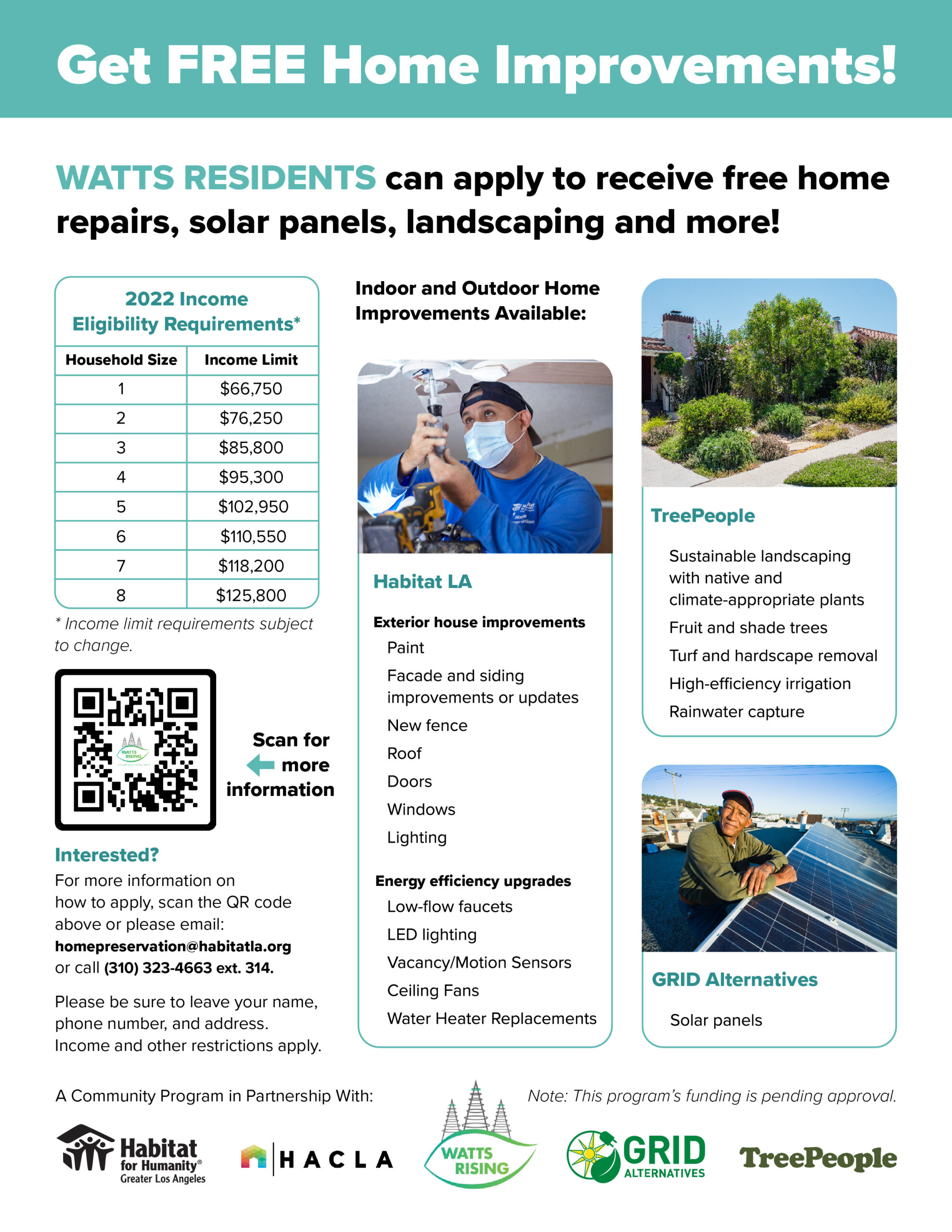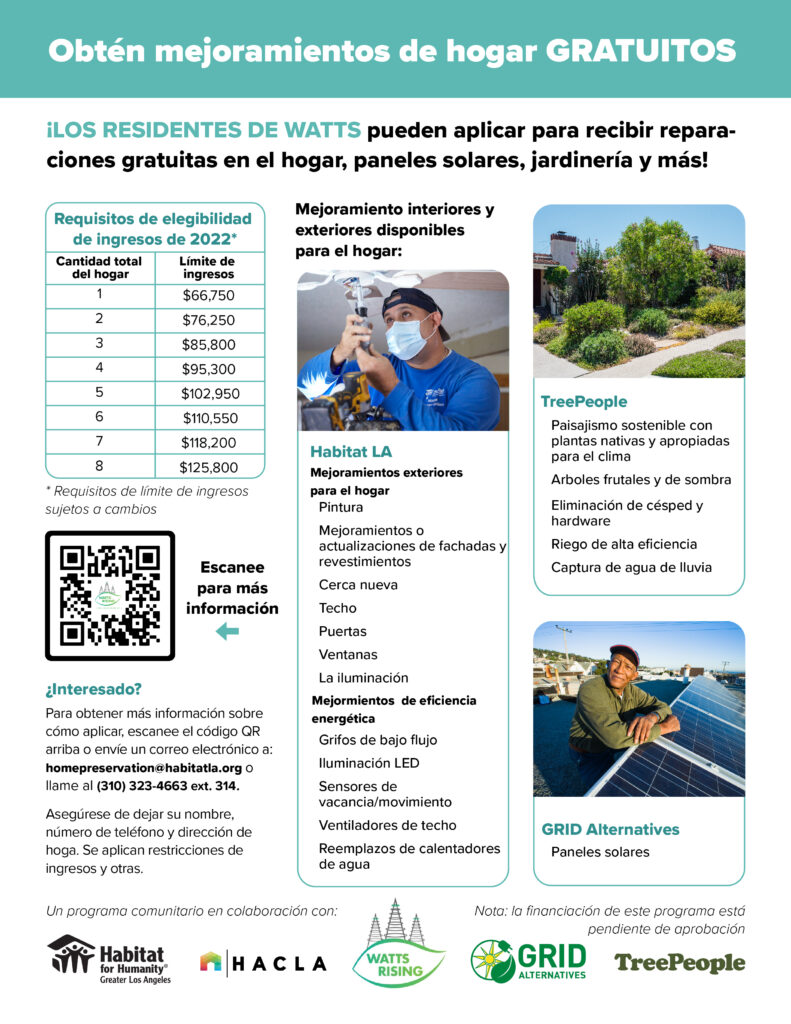
Los investigadores de la UCLA han seguido el progreso en cinco comunidades que han recibido decenas de millones de dólares del programa TCC: Fresno, Ontario, Stockton y los barrios de Los Ángeles del noreste del Valle de San Fernando y Watts. En todas las comunidades, hay algunos proyectos comunes (como la instalación de paneles solares en viviendas de bajos ingresos y la mejora de las opciones de movilidad para desplazarse sin un coche caro y/o contaminante) que permiten a los hogares ayudar al medio ambiente y, al mismo tiempo, a sus bolsillos.
Los investigadores de UCLA han seguido el progreso en cinco comunidades que han recibido cada una decenas de millones de dólares del programa TCC: Fresno, Ontario, Stockton y los vecindarios de Los Ángeles en el noreste del Valle de San Fernando y Watts. Leer más aquí.

Entrevista realizada por Valery Holguín
Blog escrito por Jannet Cordova |
Las mejoras en el hogar pueden ser extremadamente costosas, lo que hace que algunos propietarios pospongan estas reparaciones y mejoras por algún tiempo. Sin embargo, esto hace que la reparación o mejora sea aún más costosa y requerirá más tiempo y dinero. Afortunadamente, Habitat for Humanity, una organización sin fines de lucro ubicada en Watts, ayuda a las familias a construir y mejorar su espacio habitable sin costo alguno a través de su programa Watts Rising Energy Efficiency Upgrade. Fue a través de este programa que Thelma Gavin-Bowman, residente de Watts, pudo recibir las mejoras que su hogar necesitaba sin costo alguno para ella.
Thelma explica que recibió un “calentador cableado, dos aires acondicionados, un ventilador de techo, un grifo de cocina y dos cabezales de ducha para mi casa”. Estas mejoras fueron gratuitas y ella las describe como “absolutamente maravillosas”.
Las mejoras se instalaron en dos o tres días, describe. “Entraron, echaron un vistazo, hicieron todo profesionalmente y salieron de mi casa sin ensuciar”. Thelma se acercó a Hábitat para la Humanidad cuando su calentador de agua se averió, pero le quedaron aún más mejoras para renovar completamente su casa.
“Yo diría que el programa me ayudó a ahorrar al menos diez mil dólares... de mi bolsillo esos costos habrían sido muy altos”, explica Thelma. Mencionó el costo adicional de mano de obra que se habría agregado si ella misma hubiera realizado estas mejoras.
Cuando se le preguntó si recomendaría este programa, dijo que ya lo hace. “Ya se lo dije a mis vecinos y a todas las personas con las que me cruzo en mi vecindario”. Incluso ofrece a las personas recorridos por su casa para que puedan ver estas mejoras por sí mismos. “Absolutamente, les digo a todos que este programa está bien hecho. Pago gratuito y servicio amigable... El programa fue de gran ayuda”.
Thelma expresó su gratitud por este programa y alentó a otros residentes a aprovechar el programa disponible en la comunidad de Watts. Seguramente aliviará el estrés que conlleva ser propietario de una vivienda.
Para obtener más información sobre el programa y cómo presentar la solicitud, consulte el folleto del programa. También puedes enviar un correo electrónico homepreservation@habitatla.org o llame al (310)323-4663 ext. 314 y asegúrese de dejar su nombre, número de teléfono y dirección particular. Pueden aplicarse restricciones de ingresos y de otro tipo.


PERSONAL DE SALUD PÚBLICA DE HARVARD |
Durante más de 30 años, Árboles del noreste ha estado diseñando y construyendo proyectos de restauración en Los Ángeles. La organización sin fines de lucro ha empleado a cientos de adolescentes y adultos jóvenes en vecindarios de bajos ingresos con pocos espacios verdes para plantar árboles, mejorar hábitats, construir parques y restaurar vías fluviales. La falta de espacios verdes a menudo significa una peor calidad del aire en el vecindario y la imposibilidad de descansar del calor despiadado del concreto intacto. Construir y restaurar espacios verdes puede mejorar la salud del vecindario.
JAIME DING |
En 2019, el alcalde Eric Garcetti dio a conocer un ambicioso plan para plantar 90.000 árboles en Los Ángeles para 2021 como parte del Green New Deal de Los Ángeles.
Para lograrlo, designó a la primera funcionaria forestal de la ciudad, Rachel Malarich, para dirigir la División de Silvicultura Urbana. La ciudad también autorizó una red de organizaciones sin fines de lucro y "embajadores comunitarios" para ayudar y alentar a los residentes a plantar árboles muy necesarios.
LYDIA PANTAZES |
WATTS, California — A Moses Massenburg se lo puede encontrar todos los días en la granja donde cultiva productos y enseña a la gente cómo cultivar.
“Normalmente a los agricultores les gusta evitar el calor, así que llego aquí a las 4 de la mañana”, dijo.
Massenberg vive en Watts y cultiva productos agrícolas en MudTown Farms, un parque agrícola urbano de 2,5 acres en el corazón de Watts. Los productos agrícolas cultivados en el lugar se distribuyen a la comunidad de Watts.
PERSONAL DE CONSTRUYÉNDOLO VERDE |
Los lugares que aparecen en nuestra serie de comunidades regenerativas demuestran un enfoque intencional y holístico para dar forma a los lugares donde vivimos. No se trata solo de los resultados de los proyectos, ya sea electricidad generada por energía solar y espacios verdes o empleos locales y viviendas permanentemente asequibles. Se trata de los procesos, la colaboración, el liderazgo comunitario y el cuidado que se requieren para lograr esos resultados. A través de esta serie, esperamos demostrar que todos podemos aspirar a algo más que "sostenible y asequible": colectivamente, podemos comenzar a imaginar desarrollos que revitalicen las comunidades, restauren los ecosistemas y brinden a los lugares la capacidad de evolucionar y adaptarse a cualquier cambio que depare el futuro.
Por Sammy Roth
Durante la mayor parte de este año, la gente me ha estado preguntando: ¿cuándo vas a escribir sobre la energía solar en los tejados? En concreto, ¿cuándo vas a escribir sobre las empresas de servicios públicos monopólicas que intentan recortar el exitoso programa de incentivos a la energía solar de California?
Por Sammy Roth
Periquitos y agapornis cantaban en el patio delantero de Marta Patricia Martínez mientras un equipo de instaladores solares subía a su techo.
Era una cálida tarde de verano en Watts, un barrio predominantemente latino y negro en el sur de Los Ángeles. Las familias de bajos ingresos se enfrentaban al espectro de facturas de energía extremadamente altas si encendían el aire acondicionado.
Para Martínez, los paneles solares ofrecían una solución demasiado buena para ser verdad.
TONY BARBOZA, RUBÉN VIVES |
Era un típico día de verano en Los Ángeles, pero un satélite que orbitaba a cientos de millas sobre la Tierra pudo detectar que en algunos barrios hacía mucho más calor que en otros.
En una zona mayoritariamente blanca de Silver Lake —donde el ingreso familiar promedio es de más de $98,000 al año y los árboles maduros salpican las calles montañosas con su sombra— la temperatura de la superficie era de 96,4 grados.
A menos de una milla de distancia, en un rincón de East Hollywood, la temperatura era de 102,7 grados. La zona, predominantemente latina y asiática, donde el ingreso familiar promedio es inferior a $27.000 al año, está repleta de edificios de apartamentos antiguos de dos y tres pisos. Tiene pocos árboles lo suficientemente grandes como para dar sombra y menos de un tercio del dosel de Silver Lake, lo que la ubica entre las áreas con menor cobertura de la ciudad.
Página siguiente »